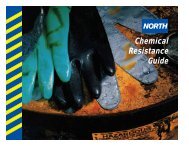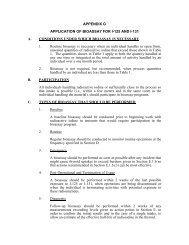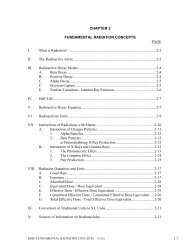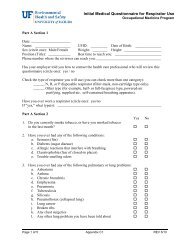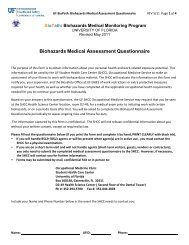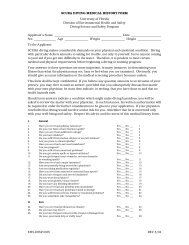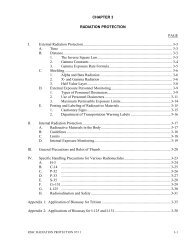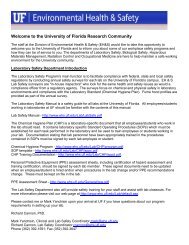Aerosols or droplets expelled by the animal from coughing, sneezing, barking, etc.,Vector-borne transmission <strong>of</strong> disease from fleas, ticks, and other arthropods that may be on theanimal.Non-human Primates (NHPs)Disease transmission to and from non-human primates is <strong>of</strong> particular concern. The Animal ContactMedical Monitoring Program addresses the health risks <strong>of</strong> work with these animals, primarily tuberculosisand B-Virus (Herpesvirus simiae) infection. Please familiarize yourself with this information as well as thatprovided by Animal Care Services if you will work with NHPs. See table below for examples <strong>of</strong> humanand NHP pathogens.Examples <strong>of</strong> Human and Non-human Primate PathogensAgentDiseasesVariola virusSmallpox in humansPolio virusParalytic poliomyelitis in humansVibrio parahemolyticusShellfish poisoning in humansNon-zoonotic Influenza Flu in humans. Humans have native influenza viruses inaddition to potentially being infected by influenza viruses fromother species.Human Immunodeficiency Virus (HIV) AIDS in humansSimian Immunodeficiency Virus (SIV) AIDS in NHPs. HIV and SIV are very closely relatedgenetically.Herpes Simplex-1 VirusCold sores in humans; rapidly fatal brain and central nervoussystem disease in some NHPsCerocopithicene Herpes simiae B virus Cold sores in NHPs; rapidly fatal brain and central nervoussystem disease in humansContainment: Animal Biosafety LevelsFour biosafety levels are described for activities involving infectious disease work with commonly usedexperimental animals. These four levels <strong>of</strong> combined practices, safety equipment, administrative controls,and laboratory facility design and features are designated Animal Biosafety Levels (ABSL) 1, 2, 3, and 4,and provide increasing levels <strong>of</strong> protection to personnel and the environment. See Table 3 for a summary<strong>of</strong> these Animal Biosafety Levels and the BMBL, 5 th edition Section V—Vertebrate Animal Biosafety LevelCriteria for Vivarium Research Facilities for a more detailed description. No ABSL4 experiments arepermitted at UF.One additional biosafety level designated BSL3-Agriculture (or BSL3-Ag) addresses activities involvinglarge or loose-housed animals and/or studies involving agents designated as High ConsequencePathogens by the USDA. BSL3-Ag laboratories are designed so that the laboratory facility itself acts as aprimary barrier to prevent release <strong>of</strong> infectious agents into the environment. More information on thedesign and operation <strong>of</strong> BSL3-Ag facilities and USDA High Consequence Pathogens is provided inAppendix D <strong>of</strong> the BMBL.NIH Guidelines for rDNA Experiments Involving Whole AnimalsThe NIH also devotes a section <strong>of</strong> the NIH Guidelines for experiments involving whole animals in whichthe animal's genome has been altered by stable introduction <strong>of</strong> recombinant or synthetic nucleic acidmolecules, or nucleic acids derived therefrom, into the germ-line (transgenic animals) and experimentsinvolving viable recombinant or synthetic nucleic acid molecule-modified microorganisms tested on wholeanimals. Appendix Q <strong>of</strong> the NIH Guidelines specifically addresses the physical and biological containment<strong>of</strong> large-sized animals, or those that have growth requirements (e.g. cattle, swine, sheep, goats, horses,and poultry) that preclude the use <strong>of</strong> typical containment for laboratory animals.Animal Contact Medical Monitoring ProgramIndividuals who will be working with animals or in proximity to animals are required to participate in theAnimal Contact Medical Monitoring Program, an educational and medical monitoring program designed toprotect UF employees, students, and volunteers from animal-related illnesses. Medical monitoring isbased on the type and frequency <strong>of</strong> exposure to animals and consists <strong>of</strong> a risk assessment, follow-up13
assessments and tests/immunizations as needed. It is part <strong>of</strong> the UF Occupational Medicine Program.The educational section provides individuals with health information specific to animal contact andpromotes safe work practices. The requirements <strong>of</strong> the program are based upon those outlined in thePublic Health Services document, Guide for the Care and Use <strong>of</strong> Laboratory Animals and OccupationalHealth and <strong>Safety</strong> in the Care and Use <strong>of</strong> Research Animals published by the National Research Council.For more information on the Animal Contact Medical Monitoring Program, please refer to theOccupational Medicine Program section <strong>of</strong> this manual.Plant Pathogens and GreenhousesState and Federal RegulationsThe movement, use, possession, or release <strong>of</strong> exotic or potentially harmful plant-associated arthropods,biological control agents, plant pests, plant pathogens, noxious weeds, and invasive plants are regulatedby the State <strong>of</strong> <strong>Florida</strong> as well as the USDA APHIS Plant Protection and Quarantine Office (PPQ). Theuse <strong>of</strong> these regulated materials will require a <strong>Biological</strong> Agent registration with the Biosafety Office inaddition to the appropriate state or federal permits.Note that some plant pathogens are controlled for export and regulated as select agents. The current listcan be found at National Select Agency Registry Website. There are additional plant pathogens not onthe select agent list that are also regulated for export. Please see the Bioagent Export Control List.Plant research involving noxious weeds, invasive plants, and certain plant pests, plant-associatedmicrobes, and plant diseases (such as citrus canker) are regulated by the <strong>Florida</strong> Dept. <strong>of</strong> Agriculture &Consumer Services, especially when the import, export, or transfer <strong>of</strong> these materials is required. Contactthe Division <strong>of</strong> Plant Industry (DPI) for rules and regulations.The USDA-APHIS also regulates plant pests, plants and plant products and the movement, importation,and field release <strong>of</strong> genetically-engineered plants and arthropods. See the detailed APHIS website forinformation, applications, permits, and notification documents. All field releases require IBC approval inaddition to Federal and State approval. The Biosafety Office and/or IBC will request current versions <strong>of</strong>field release approvals as part <strong>of</strong> recombinant or synthetic nucleic acid molecules or field release projectapproval or continuation. In addition to the USDA APHIS, State <strong>of</strong> <strong>Florida</strong> Division <strong>of</strong> Plant Industry,USDA Biotechnology Regulatory Service (BRS), FDA (for genetically altered food crops), and EPA (forgenetically modified organisms with pest control activity) may also regulate research with transgenicplants and plant-associated organisms.The following websites provide an overview <strong>of</strong> the regulatory process and related links: <strong>Florida</strong> Dept. <strong>of</strong> Ag. & Consumer Services, Dept. <strong>of</strong> Plant Industry (FDACS–DPI) USDA Biotechnology Regulatory Service (BRS) – 7CFR Part 340 USDA Plant Protection & Quarantine (PPQ) – 7 CFR Part 330 NIH Guidelines Appendix P (recombinant or synthetic nucleic acid molecules , transgenics,GMOs) APHIS PPQ Containment Guidelines FDA, for plant made pharmaceuticals or biotech foods and feeds EPA, for plant incorporated protectantsVideo links from the “Regulatory Biosafety for Plant Research” symposium held on April 2010 at UF areavailable below for reference Regulation <strong>of</strong> Agricultural Biotechnology Products in the U.S PPQ Plant Pest and Biocontrol Permitting Policy State <strong>of</strong> <strong>Florida</strong> Perspective on Plant Pest Permitting14
- Page 1: UNIVERSITYBiosafetyManual2014OFFLOR
- Page 5 and 6: Hurricane Watch ...................
- Page 7 and 8: Authority & ResponsibilitiesBy auth
- Page 9 and 10: All projects involving recombinant
- Page 11 and 12: Tools for Risk AssessmentBoth the N
- Page 13: The risk assessment will also deter
- Page 17 and 18: protection of workers and the envir
- Page 20 and 21: Have limited toxicological data app
- Page 23 and 24: Integration of rAAV genomic sequenc
- Page 26 and 27: from fowlpox virus) are most widely
- Page 28 and 29: S+/L- assay: Vector stocks are ampl
- Page 30 and 31: Kenneth Cornetta, Jing Yao, Aparna
- Page 32 and 33: material. The catalyst for increase
- Page 34: Engineering ControlsThese devices a
- Page 38: PPE to protect eyes and face is use
- Page 41 and 42: DisinfectantsDisinfectants are chem
- Page 43 and 44: Formaldehyde Gas (from heating para
- Page 45 and 46: Call Building Services, 294-5500, t
- Page 47 and 48: Autoclave use log must be available
- Page 49 and 50: After the disaster has occurred, de
- Page 51 and 52: Workplace ViolenceAll threats and o
- Page 53 and 54: Account for coworkersWait for any i
- Page 55 and 56: 4. The physician may wish to consul
- Page 57 and 58: Spill Outside the LaboratorySafe tr
- Page 59 and 60: An emergency room should only be us
- Page 61 and 62: staff notifies the PI of any person
- Page 63 and 64: Departments: Assist EH&S in identif
- Page 65 and 66:
Investigational New Drug (IND) Vacc
- Page 67 and 68:
Transport of Biological Materials o
- Page 69 and 70:
All human, animal, or plant pathoge
- Page 71 and 72:
Special IssuesHIV Research Laborato
- Page 73 and 74:
Symptoms suggestive of B virus infe
- Page 75 and 76:
tuberculosis are a potential source
- Page 77 and 78:
Table 2. Summary of Recommended Bio
- Page 80 and 81:
Table 4: Select Agents and Toxins79
- Page 82 and 83:
Table 6: Summary of NIH Guidelines;
- Page 84 and 85:
Section Subsection Research Applica
- Page 86 and 87:
App C-IVKluyveromyces Host-Vector S
- Page 88 and 89:
Table 8: Summary of Biosafety of Vi
- Page 90 and 91:
ResourcesBiosafety Resources: http:
- Page 92 and 93:
OCCMEDOPIMOSHAPAPRPIPPEPPQPSDSRACrD
- Page 94 and 95:
ParenteralPathogenPathogenicityPers
- Page 96 and 97:
Plant, Plant Pests, Noxious Weeds,a
- Page 98 and 99:
Select Agent RegulationsAnimal, Ani
- Page 100 and 101:
Transportation RegulationsTransport




